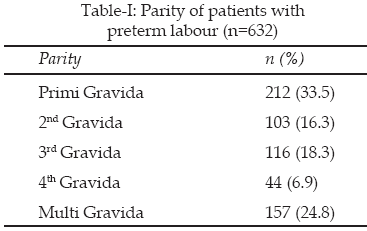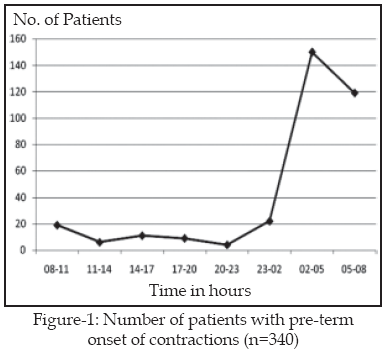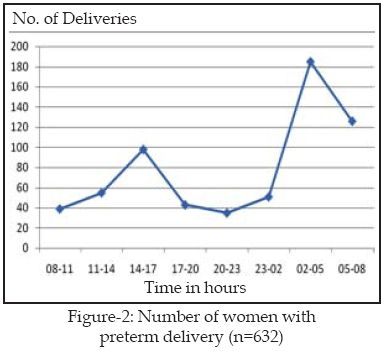|
 |
|
Published
by : PROFESSIONAL MEDICAL PUBLICATIONS |
|
ISSN 1681-715X |
|
|
|
|
|
- |
|
ORIGINAL
ARTICLE |
|
- |
|
Volume 25 |
October - December 2009
(Part-II) |
Number 6 |
|
|
|
Diurnal influence to the onset
of preterm Delivery
Shabeen Naz Masood1, Farida Khan2,
Muhammad Faraz Masood3
ABSTRACT
Objective: To analyse the onset of
uterine contractions and preterm delivery in order to document any diurnal
influence.
Methodology: Hospital records of the
patients admitted with the diagnosis of preterm labor were retrieved from
January 2003 to February 2007 from Sobhraj Maternity Hospital, Karachi. Time
of onset of uterine contractions establishment of preterm labor parity and
gender of the baby was noted. Data was analyzed by SPSS version 10 for
descriptive and inferential statistics.
Results: During the study period, 632
preterm deliveries were recorded. Precise timing of onset of uterine
contractions was available in 340 (38.33%) deliveries. Uterine contraction
leading to labor started from 2:00AM to 5:00AM and 397 babies delivered during
the night / early morning (8:00 PM to 8:00 AM) and 235 babies were delivered
during day (8:00AM to 8:00PM) [chi2 = 7.908; p= 0.004]. Among all babies
delivered during night / early morning 311 (49.2%) were born between 2:00AM to
8:00AM.
Conclusion: Preterm labours demonstrate
diurnal rhythm. In most of the women, contractions started between 2:00AM -
5:00AM and most of the deliveries occurred from 2:00AM - 8:00AM.
Keywords:
Preterm labour, Preterm delivery, Diurnal rhythm.
Pak J Med Sci October - December
2009 (Part-II) Vol. 25 No. 6 1003-1006
How to cite this article:
Masood SN, Khan F, Masood MF. Diurnal influence to the onset of
preterm Delivery. Pak J Med Sci 2009;25(6):1003-1006.
1. Dr. Shabeen Naz Masood, MCPS,
FCPS,PhD,DCPS
Consultant Obstetrician & Gynaecologist &
Medical Superintendent
Sobhraj Maternity Hospital,
City District Govt. Karachi.
2. Dr. Farida Khan, MBBS, MCPS,
Postgraduate Trainee (Obs/Gyn)
Sobhraj Maternity Hospital,
City District Govt. Karachi.
3. Dr. Muhammad Faraz Masood, MD,
Department of Surgery,
Detroit Medical Centre,
Wayne State University,
Detroit, Michigan, USA.
Correspondence
Dr. Shabeen Naz Masood,
Consultant Obstetrician & Gynaecologist &
Medical Superintendent
Sobhraj Maternity Hospital,
City District Govt,
Karachi - Pakistan.
Email: sh_naz@yahoo.com
* Received for Publication: June 14, 2009
* Accepted: October 31, 2009
INTRODUCTION
Preterm labor refers to the onset of uterine contractions
of sufficient strength and frequency to effect progressive dilatation and
effacement of cervix between 20 and 37 weeks of gestation.
1
It is often conjectured that frequency of birth vary with the time of the year
and the time of the day.2
As far as diurnal rhythms of labor onset in women are concerned, a clear peak
occurs during night hours, although the mechanisms actually determining the
onset of labor are still unexplained.3
Because uterine contractions and
the labor-inducing hormone oxytocin also show strong diurnal rhythms, a
leading role of the hypothalamus/pituitary is likely.4
Preterm labor complicates 5-10% of pregnancies and is a
leading cause of neonatal morbidity and mortality.
5
It is a major public health problem in terms of loss of life, long-term
disability and have health care costs both in the developing and the developed
world.6-8
Whether preterm labour represents an early maturation of a physiological
process or alternatively, an entirely pathological process, is uncertain. It
has also been suggested that late onset preterm labour may represent a
physiological mechanism whilst early preterm labour is a pathological
mechanism.9
In hospital practice, times of labor and deliveries are
often not in a favorable phase with the working hours. This is especially
important in term of preterm labor as its effective management will improve
neonatal outcome and will have impact on healthcare costs. This study was done
to document the timing of onset of uterine contractions when preterm labour
resulted in delivery and also timing of preterm deliveries.
METHODOLOGY
From January 2003 to February 2007, hospital records of all
patients admitted with the diagnosis of preterm labour was retrieved from
Sobhraj Maternity Hospital, Karachi. The recorded time of onset of uterine
contractions was obtained. Only precise times recorded by doctor or nursing
staff were included in the analysis. The first uterine contraction time was
approximated to the nearest hour. Timing of onset of preterm labor was
recorded with gender of baby along with parity of women. Data was analyzed by
using SPSS version 10 for descriptive and inferential statistics.
RESULTS
A total of 10,544 deliveries were recorded during the three
years period. Total 887 women were admitted with the diagnosis of pre-term
labour and out of them 632 were delivered (309 male and 323 female babies).

Two hundred twelve (33.5%) women were primi gravid and 157
(24.8%) women were multigravida [Table-I]. Precise timing of onset of uterine
contractions was available in only 340 (38.33%) deliveries which shows peak in
the early morning [Figure-1].

In all preterm deliveries, 397 babies were delivered during
the night / early morning (8:00 PM to 8:00 AM) and 235 babies were delivered
during day (8:00AM to 8:00PM) [chi2 = 7.908; p= 0.004]. Among all babies
delivered during early morning 311 (49.2%) were born between 2:00AM to 8:00AM
[Figure-2].

DISCUSSION
Our results showed there is a diurnal variation of preterm
labour and most of them delivered during late night / early morning when the
staff both medical as well as paramedical was small in number. Prevention and
treatment of preterm labor is essential to reduce adverse neonatal and infant
outcome and to improve survival and quality of life. This highlights the
importance of increase availability of resources during late night and early
morning so that proper management of preterm deliveries could be ascertained.
Many developing countries like Pakistan are unable to cope with the healthcare
costs associated with managing neonates that are born preterm, resulting in
higher and often unacceptable neonatal morbidity and mortality.
Lindow et al
9
analyzed 425 cases of preterm labour and reported that there was significant
difference between number of women who went into labour during night compared
with those during day time (p<0.0001). There was no difference noted between
gender of baby and singleton or multiple births. In their study 42% of women
delivered who went into labour in six hour period between midnight and 6 AM.
In our study, 311 (49.2%) of the women had delivered between 2:00AM to 8:00AM
[Figure-2].
Fraser WD et al
10
found that in women having spontaneous onset of labour or premature rupture of
the membranes there is a marked diurnal variation in times of admission to
hospital. Analysis of 4755 nulliparous women with single pregnancies in
cephalic presentation at term indicated that they presented in labour or with
premature rupture of the membranes nearly twice as frequently during the night
as during the evening. The peak hours for delivery were late morning and
afternoon.10
A very interesting study was published from Switzerland in
2008 by Lerchl et al.
11
in which birth dates from almost three million babies born between 1969 and
2005 in Switzerland were analyzed for the weekday of birth. A very marked
non-random distribution was discovered with decreasing numbers of births on
weekends. While most of this weekend births missing rate is due to fewer
births on Sundays (up to "21.7%), the downward trend is primarily a
consequence of decreasing births on Saturdays (up to "14.5%). For 2005, these
percentages mean that 3,728 fewer babies are born during weekends than could
be expected from equal distribution. The increasing absence of births during
weekends is discussed as being a consequence of decreasing numbers of
caesarean sections and elective labor induction, which in Switzerland reached
29.2 and 20.5%, respectively, in 2004. Another interesting observation was
reported by Goldstick et al.12
while investigating the diurnal rhythms of ‘urgent’ operative deliveries
(caesarean sections and operative vaginal delivery) and found a strong diurnal
rhythm with highest frequencies during the normal working hours. The rate of
urgent caesarean deliveries increased significantly between 8 a.m. and 2 p.m.
They concluded that perhaps this effect is caused by varying definition of
‘urgency’ according to the time of the day and is man made.
Diagnosing preterm delivery is equally important as
managing it. In most reports, only 30-40% of women hospitalized for
spontaneous preterm labour experienced a preterm birth, suggesting a low
positive predictive value of clinical diagnosis.
13
Transvaginal ultrasonographic scanning (TVUSS) of cervical length has shown a
high sensitivity for preterm birth, 90-100% for preterm birth before 33-35
weeks, using a liberal cutoff at 30 mm. Assessment of cervico vaginal fetal
fibronectin (FFN) levels has shown a sensitivity of about 80%. Adding FFN
assessment to TVUSS might contribute significantly to the prediction of
preterm birth.14
Home uterine activity monitoring (HUAM) is based on the principle of toco
dynamometry has created a lot of interest and excitement among obstetricians
when it was first introduced.6
Uterine contractions occurring before labor have been studied using this unit
which documented the hourly number of contractions which occurred prior to
labor from 24 weeks onwards.15
It was found that there is a strong diurnal variation to non-labour uterine
contractions which increases as gestational age increases. Uterine contraction
frequency reached a maximum in the early hours of the morning. The authors
also noted that rest decreased uterine activity, while sexual intercourse
increased it. A similar nocturnal rise in non-labor uterine activity was
reported by Vercoustre L.16
However, a large randomized trial involving 2422 patients showed no
benefit of HUAM in predicting preterm labor.17
The etiology of increasing myometrial activity and increasing myometrial
sensitivity to oxytocins is due to rising number of oxytocin and prostoglin
receptors in myometrium as pregnancy advances. Development of gap junctions
and rising production of prostaglandines from decidual tissue is a normal
developmental change with increasing gestational age.
Unfortunately, the incidence of preterm labor has changed
very little over the last 40 years and uncertainties still persist regarding
the best strategies for its management.
6,18
It has been widely recognized that its prevention and effective management
will improve neonatal outcome and will have a profound impact on societal and
long-term public healthcare costs.1
Our study highlights an important aspect of management of preterm deliveries
because most of the women have their onset of labour and consequent birth at
odd hours when the health care facilities in any hospital are very meager.
There is need of increase in vigilance at these odd hours by adequate number
of properly trained staff for the management of preterm labour.
REFERENCES
1. Jayasooriya GS, Lamont RF. The use of progesterone and
other progestational agents to prevent spontaneous preterm labour and preterm
birth. Expert Opin Pharmacother 2009;10(6):1007-16.
2. Anderka M, Declercq ER, Smith W. A time to be born. Am J
Public Health 2000;90(1):124-6.
3. Ngwenya S, Lindow SW. 24 hour rhythm in the timing of
pre-labour spontaneous rupture of membranes at term. Eur J Obstet Gynecol
Reprod Biol 2004;112(2):151-3.
4. Liedman R, Hansson SR, Igidbashian S, Akerlund M.
Myometrial oxytocin receptor mRNA concentrations at preterm and term delivery
- the influence of external oxytocin. Gynecol Endocrinol 2009;25(3):188-93.
5. Yoneyama K, Kimura A, Kogo M, Kiuchi Y, Morimoto T, Okai
T. Clinical predictive factors for preterm birth in women with threatened
preterm labour or preterm premature ruptured membranes? Aust N Z J Obstet
Gynaecol 2009;49(1):16-21.
6. Chandraharan E, Arulkumaran S. Recent advances in the
management of preterm labor. J Obstet Gynecol India 2005;55(2):118- 24.
7. Ghazi A, Jabbar S, Siddiq NM. Preterm labor - still a
challenge! Pak J Surg 2006;22(4):222-6.
8. Ahmad K, Malik A, Yusuf W. Perinatal Morbidity and
Mortality in cases of Preterm Labour, an Antegrade Study conducted at Lady
Willingdon Hospital, Lahore. Biomedica 2000;16:74-7.
9. Lindow SW, Jha RR, Thompson JW. 24 hour rhythm to the
onset of preterm labour. Brit J Obstet Gynae 2000;107(9):1145-8.
10. Fraser WD, McLean FH, Usher RH. Diurnal variation in
admission to hospital of women in labour. Can J Surg 1989;32(1):33-5.
11. Lerchl A, Reinhard SC. Where are the Sunday babies? II.
Declining weekend birth rates in Switzerland. Naturwissenschaften
2008;95(2):161-4.
12. Goldstick O, Weissman A, Drugan A. The circadian rhythm
of "urgent" operative deliveries. Isr Med Assoc J 2003;5(8):564-6.
13. Hayashi RH, Mozurkewich EL. How to diagnose preterm
labor: a clinical dilemma. Clin Obstet Gynecol 2000;43(4):768-77.
14. Herbst A, Nilsson C. Diagnosis of early preterm labour.
Brit J Obstet Gynae 2006 Dec;113 Suppl 3:60-7.
15. Moore TR, Iams JD, Creasy RK, Burau KD, Davidson AL.
Diurnal and gestational patterns of uterine activity in normal human preg-
nancy. Obstet Gynecol 1994;83517-523.
16. Vercoustre L. Uterine activity and premature delivery.
Review of the literature. J Gynecol Obstet Biol Reprod 1997;26(2):131-6.
17. Dyson DC, Danbe KH, Bamber JH. Monitoring women at high
risk of preterm labor. N Eng J Med 1998;338:15-9.
18. Iqbal A, Nausheen F, Bhatti FA. Management of preterm labor Ann King
Edward Med Coll 2004;10(4):423-6.
HOME
| SEARCH
| CURRENT
ISSUE | PAST
ISSUES
Professional
Medical Publications
Room No. 522, 5th Floor, Panorama Centre
Building No. 2, P.O. Box 8766, Saddar, Karachi - Pakistan.
Phones : 5688791, 5689285 Fax : 5689860
pjms@



